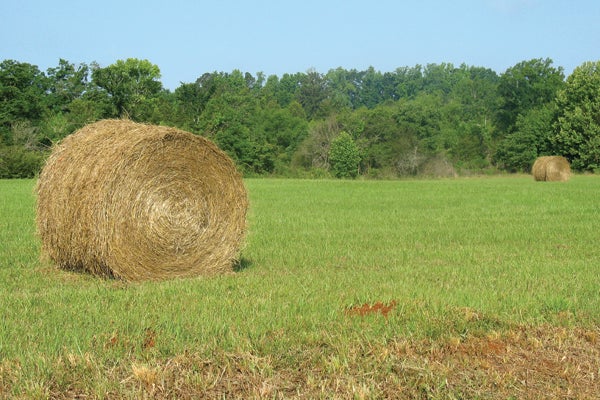
By Joshua Elmore | Regional Extension Agent
Recently, the old phrase “make hay when the sun shines” has been taken to heart by area farmers.
Driving any country road this time of year, we see the first, and sometimes second, cutting of hay being baled all over Chilton County. Hay bales dot the landscape, signifying the first signs of the summer to come.
On the majority of farms, the emphasis of hay production is on the amount of hay produced per acre. However, the most important consideration is not the quantity of hay produced, but the quantity of available and digestible nutrients stored and the level of animal performance resulting from feeding those nutrients.
In the Southeast, forages are the backbone of successful livestock operations. In a broad sense, forages can be any part of a plant consumed by a grazing animal or harvested for feeding.
Generally, the term “forage” refers to pastures, hay or silage. While grazing forages can reduce the amount of stored feed needed for animal care and production, there are certain times of the year when grazing may not be an option.
When pasture growth is limited, it is necessary to provide fodder for livestock.
Hay offers a number of benefits: it can be mechanically harvested, it stores well when effectively protected and it may meet the nutritional requirements for most classes of livestock.
Hay fits into a grazing system, because excess forage can be cut, thus minimizing waste. Harvesting excess forage growth also results in the production of young, tender re-growth for later grazing.
Since hay is the primary feed source for livestock during the winter, it is viewed as a necessity by the majority of livestock owners and leaves them with two options: bale it or buy it.
When considering the economics of hay production, you have to keep in mind that a large percentage of costs are fixed, meaning regardless of other factors, these costs will remain.
From strictly an economic perspective, it is extremely difficult for a small producer to justify producing their own hay. However, if a producer is going to spend the time, money and effort to produce hay, they should strive to make it worthwhile, focusing on high-quality, high-yielding, efficiently produced hay.
The single most important producer-controlled factor influencing hay quality is stage of maturity at harvest. This is where many Southern livestock producers can improve hay quality most easily and dramatically.
Stage of maturity at harvest influences the palatability, crude protein content and the digestible energy level. Cutting hay past the recommended stage results in increased fiber content as well as decreasing palatability and digestibility. Waiting to harvest will generally increase the number of bales produced, but nutritive value decreases.
In addition to requiring more fuel, time and labor to store the high-fiber hay, animal performance will be depressed. Poor quality hay passes more slowly through the animal digestive system, causing lower intake of low-quality hay, which further reduces animal performance.
Most hay sold in the United States is sold by the bale, based on either color or forage type, with very little concern over nutritive quality.
Good-quality hay is often sold too cheap, and poor-quality hay is often sold for more than it is worth. Poor-quality hay is low in both protein and energy and is usually high in fiber.
Observations of hay for leafiness, softness, color, odor, dust and foreign materials are great indicators of quality; however, nutritive value of hay must be measured. The only way to determine the nutrient value of hay is to have a sample analyzed at a testing facility like Auburn University.
To obtain accurate results from such tests, a representative sample must be collected. Once the results of a test are obtained and the quality of a lot of hay is known, that information can be used in effectively formulating diets for livestock.
Hay testing and forage quality are just a few of the programs we will offer on June 29 at the Central Alabama Forage Field Day at the Chilton Research and Extension Center in Clanton.
Speakers from the Alabama Cooperative Extension System will present several “best management practices” for pasture and forage producers in Central Alabama.
This event offers a new learning opportunity for all livestock producers, horse owners and hay producers to help set the stage for their success in forage production.
The cost to attend is $10 a person (price includes lunch). If you are interested in the field day, call the Chilton County Extension Office at (205) 280-6268 to pre-register. Registration details and directions may be found at: www.aces.edu/animalforage/.
For more information on forage production, visit the Alabama Cooperative Extension System website at: www.aces.edu/agriculture/livestock-poultry/.
